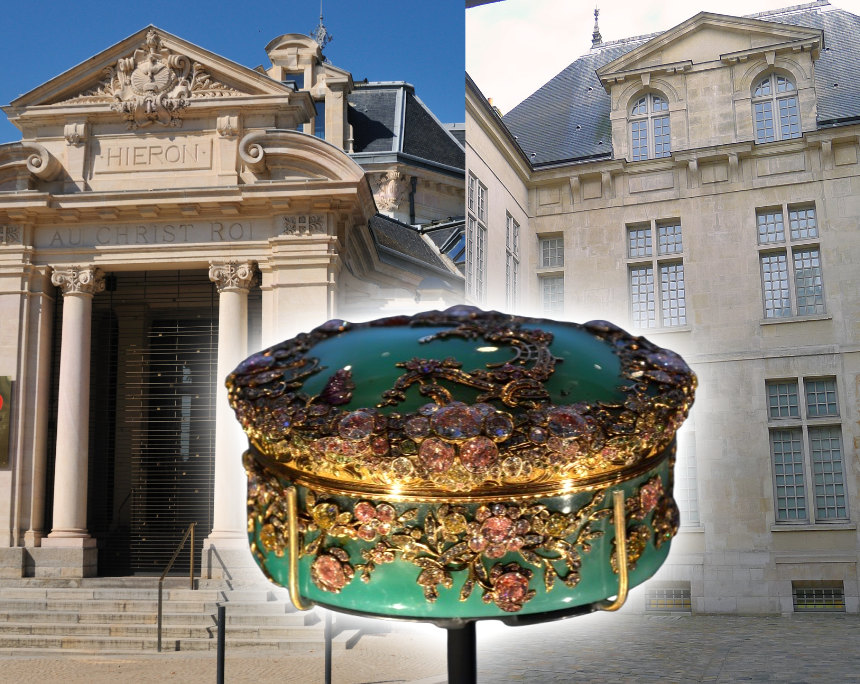Two Robberies in Two Days – French Museums Targeted by Criminals
by Daniel Baumbach
Remember how museum heists used to work in the movies? It took ingenious plans, deceptive manoeuvres, high-tech and at least one acrobat. Security was outwitted and the coveted object was elegantly captured in a night-time coup.
Content
In today’s reality, success is achieved through something completely different: blunt, ruthless and violent action. This was demonstrated just last week by two attacks on French museums on two consecutive days.

The Cognacq-Jay museum is housed in the historic Hotel Donon. Photo: Mbzt via Wikimedia Commons, CC BY 3.0.
Case 1 – Wednesday, Cognacq-Jay Museum, Paris
The first robbery took place on 20 November at the Cognacq-Jay Museum in Paris. The museum houses the collection of furniture and other art objects belonging to the family of the same name, who founded the famous luxury store La Samaritaine in Paris in 1869. The museum is currently hosting a special exhibition entitled “Luxe de poche”, which showcases small but lavishly decorated 18th-century objects made from precious stones and gold. The exhibition was due to close in September, but was extended until 24 November because it was so popular with the public. A few days before the exhibition was scheduled to end, at around half past ten in the morning, i.e. during opening hours, four masked men are said to have stormed the museum. Armed with axes and baseball bats, they entered the exhibition and smashed display cases. They then fled on two scooters with their loot. Visitors and staff were left terrified but unharmed.

This 1765 snuff box from the Victoria and Albert Museum is one of the stolen items. Photo: User Vassil über WikiMedia Commons.
The Loot
Seven valuable 18th-century snuff boxes were stolen during the robbery, the city of Paris museums have now announced. The snuff boxes were among the most valuable of their kind and were on all loan from the Louvre, the British Royal Collection Trust and the Victoria and Albert Museum. An initial estimate puts their value at around one million euros.
One of the pieces from the Royal Collection Trust is said to have come from the estate of King Frederick the Great of Prussia. This piece alone is decorated with almost 3,000 diamonds. A full list of the stolen snuff boxes can be found here.

The Hiéron Museum at Paray-le-Monial, Bourgogne-Franche-Comté region. Photo: Croquant via Wikimedia Commons, CC BY-SA 3.0.)
Case 2 – Thursday, Hiéron Museum, Paray-le-Monial
The very next day, a similar attack occurred at the Hiéron Museum in the small town of Paray-le-Monial in central France, northwest of Lyon. The museum specialises in Christian religious art since the Middle Ages.
On the afternoon of 21 November, once again in broad daylight and during opening hours, three armed men entered the museum while a fourth stood guard outside. They fired shots, probably to frighten the 20 or so visitors and staff present. They then turned their attention to their target: the three-metre-high sculpture “Via Vitae”.
Destroyed Art
The work by the famous goldsmith Joseph Chaumet was considered the highlight of the museum and was classified as a French national treasure. It is a mountain of marble decorated with diamonds, rubies, emeralds and alabaster, featuring 138 gold and ivory figures depicting the life of Jesus Christ. The 1906 work of art was valued at 7 million euros.
Using a heavy, electrically-powered tool, the perpetrators first smashed the bullet-proof glass and then cut through the marble base. They then ripped out the valuable ornaments and figurines. The perpetrators fled on motorcycles from the approaching police. Two police cars gave chase, but were thwarted by nails thrown onto the road by the fugitives.
It was not the first time the museum had been robbed, the Guardian reports. Two gold crowns were stolen in 2017. Another attempted break-in in 2022 was unsuccessful.
A Possible Connection?
The loot from the two robberies has one thing in common: the objects are decorated with valuable materials such as gold and precious stones, which can easily be melted down or ripped out to make money. It would not be the first time for works of art to be destroyed in this way. Just recall the case of the Celtic treasure of Manching, whose priceless gold coins were probably irretrievably destroyed for their comparatively small gold value.
It is not known yet whether there is any connection between the two robberies, which were both committed by four men. The French police are investigating. And the museum world is desperately discussing how to protect itself against such robberies.
What Can Be Done?
This is not the first time for such debates to take place. We have known some years now that objects with components of high material value require special protection. Small museums, in particular, should be better prepared for the possibility that even their silverware might be targeted by thieves.
This is easier said than done, given the notorious lack of funds in museums. Nevertheless, the headline-grabbing break-ins in Berlin and Dresden have given German museum staff enough clout to make the authorities in charge of their funding aware of the dangers to their exhibits. As a result, bullet-proof glass is said to have become impossible to obtain for some time because of the sheer volume of orders from German museums. Indeed, the unsuccessful break-in at the Rheinisches Landesmuseum in Trier shows that such money is well spent, as the defiant bulletproof glass prevented the theft of Trier’s gold coin treasure.
But what other options are there when, as in Paray-le-Monial, the perpetrators arrive with heavy equipment capable of breaking even bulletproof glass? Against whom even the best alarm system is useless because they get in through the front door during opening hours? Against whom no security guard can do anything because they have firearms? This leaves us with the bitter realisation that museums have finally reached the limits of what they can do to protect themselves.
As we reported in March of this year in an article about museum break-ins in Germany, one museum, following a break-in, took the sad but logical decision to no longer display its objects of high material value in the exhibition for security reasons. Instead, photos of the objects were displayed. A cry for help. Museums should make objects accessible to the public, but they should also protect them. It seems that doing both at the same time is becoming increasingly impossible.
We have reported on many cases in the past, but by no means all. Here is a selection of museum break-ins from recent years:












